Over many years as an affordable aviation journalist I have learned two things. First, stick to airplanes. That’s what moves the needle for most pilots; nearly always such articles are the best-read on this website. Second, pilots love more powerful engines, especially when they display new technologies.
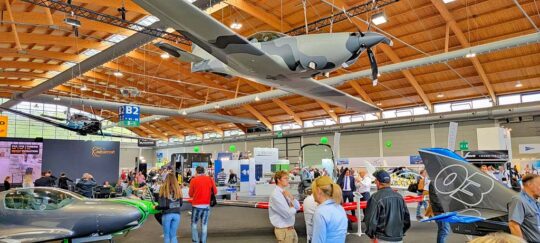
SOARING HIGH — JMB Aircraft’s display at AERO Friedrichshafen 2022. photo by John Rathmell
Speedy LSA maker, JMB Aircraft has tapped into this rich vein of interest. For some years, they have worked to make their elegant and shapely VL3 go faster than before (earlier evaluation article). A year ago at Sun ‘n Fun, the Belgium-headquartered company showed Americans their 141-horsepower Rotax 915iS model. The machine looked quick merely sitting in their display.
That wasn’t enough. Even though JMB can max out at 230 mph now, leaders and engineers at JMB thought, “Why not try a turboprop?”
JMB Turbine
Not even a month ago, this leading builder of LSA speedsters took their turbine-powered VL3 into the air for the first time, in France on Monday April 4th, 2022. Later that month, the company debuted the development to crowds at Aero Friedrichshafen 2022.
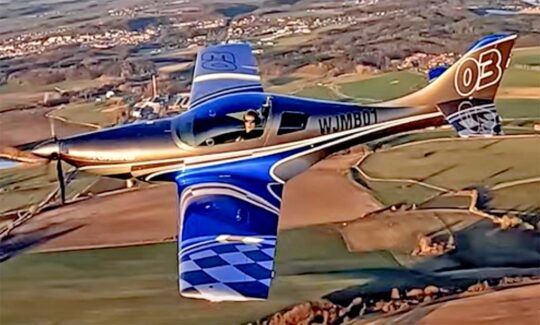
JMB has installed a French-designed engine from TurboTech (the same powerplant used on Bristell’s new entry). According to the French engine developer, the TP-R90 outputs 130 horsepower, burns five gallons per hour in “eco-cruise,” and weighs 176 pounds for the “full package” (though final installed weight may vary by airframe). TurboTech clarified, “A regenerative turbine is a turbine engine equipped with a heat exchanger (nearby diagram) capable of recovering the heat normally wasted in exhaust gases and reinjecting it into the combustion chamber, leading to a dramatic fuel burn reduction.”
Piloting the first flight of their VL3 Turbine Jean-Baptiste Guisset, CEO of JMB, flew at France’s Valenciennes airfield under the supervision of the designers of the French turbine.
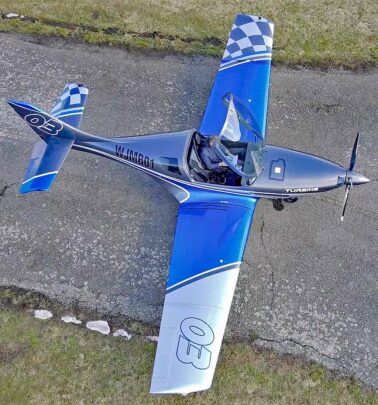
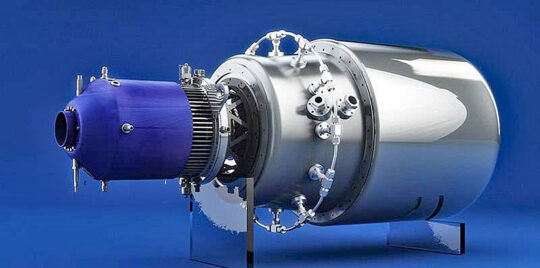
TURBINE POWER — TurboTech’s heat-exchanger turbine engine is being used on three LSA designs.
“A VL3 turbine is easier to fly than a traditional piston aircraft,” added JMB, “thanks to the electronic management of the FADEC and its unique lever.” Not only do they report modest fuel burn rates, thanks to the heat exchanger, but kerosene price is also a good advantage compared to the fuel normally used,” observed Jean-Marie Guisset.
In six months of development testing, JMB reported more than 50 hours of ground testing, including 30 hours of full power testing. “In only 8 days, we flew more than 20 hours and simulated all possible failures without any technical issues.”
“We already have two aircraft equipped with the turbine and have elaborated an advanced flight program for the coming months in order to test all the flight domains of the turbine,” concluded JMB.
Longer Life / Cheaper Fuel
Proponents of TurboTech’s method say it is superior due to its longer time before overhaul (TBO).
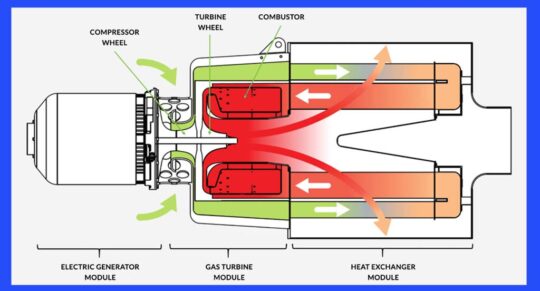
WIDER USES — TurboTech also envisions their turbine as a generator for hybrid-electric propulsion.
Other commenters cite as a primary benefit: reliability. Turbine engines run at high revolutions but are built with such precision that they can last longer than a reciprocating engine. Due to their design, reciprocating engines produce vibration. As vibration can harm an airframe over a long life, a smoother turbine may add to an airplane’s duty cycle though this is hardly a major concern for recreational planes that log 50-100 hours per year. Unless you log far more hours than average, you may never need to overhaul your turbine JMB.
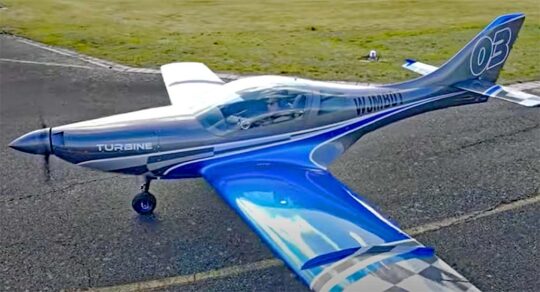
FAA’s Mosaic & Turbines?
The short answer about turbines being permitted: We don’t know today but we might find out at Oshkosh 2022 when I expect FAA will release the draft regulation as a Notice of Proposed Rule Making (NPRM).
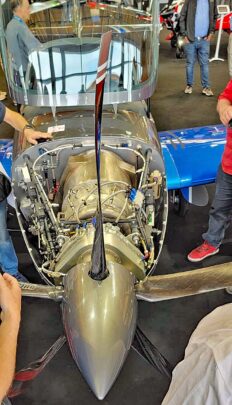
LONG & LEAN — JMB Aircraft’s installation of the TP-R90 turbine into their VL3 model. photo by John Rathmell
What we do know is that FAA deliberately eliminated turbine engines when they released the Sport Pilot / Light-Sport Aircraft regulation in 2004. In those days, a turbine engine was viewed as too complex for sport enthusiasts so FAA specified “reciprocating” engines only.
As a sign of the times way back then, electric propulsion wasn’t anything of particular interest. A few scattered experimenters had not proven battery-powered aircraft were anything more than a novelty. Requiring internal combustion engines completely ruled out electric motors… all in the interest of keeping turbines out.
Well, FAA also failed to include helicopters but Mosaic might include them. So, might FAA allow turbine, too? Possibly yes, if they are paying attention to what is going in Europe; at least three companies have fitted turbine engines to current-day LSA designs. With the advantages spelled out above, do you think rule writers can or should include turbine? If you agree, get ready to tell FAA by your comments later this year.
Will a Market Arise?
Cost is the main impediment to wider acceptance. At almost $100,000 for the engine alone (according to an estimate from Bristell rep’, John Rathmell at Aero 2022), the TurboTech power plant is almost three times as costly as a Rotax 915iS yet it outputs 10 or more horsepower less than the turbocharged, intercooled Rotax. No matter its extra benefits, that cost will prove prohibitive for most buyers. Yet if you think it won’t sell, then tell me how Cirrus keeps selling hundreds of their nearly-million-dollar SR-series aircraft year after year.
I understand most buyers will probably not elect turbine power no matter its advantages because the cost is breathtakingly higher. Nonetheless, well-heeled pilots with a need for speed and a love of the latest thing may go for it. The rest of us will fly what we can afford and the great news is — something is available for almost every budget.


This is very exciting. Thanks for the article Dan. It is interesting to see some new and more advanced powerplants being introduced in aviation like the Rotax, the Continental CD-300 and now this small turbine. Perhaps with more of these powerplants flying we will see the addition of mogas pumps at airports. Certainly the turbine will come at a price but that price could be attractive if it comes with more reliability and less maintenance costs.
They say 19 l/h (or 5 gph) in eco-cruise on their website but they don’t say how much power eco-cruise produces. Is it 100hp? 80? Less?
I don’t have that information. I recommend the TurboTech link in the article to inquire further about power at eco-cruise.
Doing some digging in various articles, the key metric that they’ve advertised for fuel consumption is meeting their goal of 340 g/kwhr for fuel consumption. If you convert it to gallons of Jet A @ 100 hp, I get 8.33 gph, which is pretty fantastic for a small GA turbine. My guess is that they will have a family of powerplants in the 100-300 horsepower range to best satisfy GA market potential. Very exciting!!!
If it uses 19 liters per hour and the fuel required is 340g/kWh, then divide the fuel weight of 19 liters to get the weight in kilograms (19×0.8kg=15.2kg) and divide this by .34 to get 44.7kW. This is multiplied by 1.341 to get 59.95HP or roughly 60HP.
This is awful fuel economy because a turbocharged Edge Performance 912 consumes only 12 liters at 80HP continuous. Anything bellow 80HP continuous is simply not enjoyable for flying, so that is why most people still opt for piston engines.
The advantages of a turbine are high power, less weight, speed offsets, fuel burn, easy access to pressurize a cabin. It can go high and cut cost in fuel and avoid icing. Longer TBO. All of that is a plus offsetting a higher cost of the engine. None of these are offered in this low-powered turbine. I can’t see how it will sell. On top of that it’s a 2 seater. What they need is a certified version that can hit 300 knots, pressurized can carry 4 people comfortably then they can compete with million dollar aircraft a lower cost version of a TBM.
It has the advantage of high efficiency without needing to be at high altitude due to the heat exchanger. It also has low vibration and high theoretical reliability. It can also run on Jet A.
Sure you can get a more powerful and more efficient engine for only a little extra weight if you’re willing to go with a Rotax and don’t mind having to do constant maintenance due to using 100LL (which, if you do a lot of cross-country, you’ll need to use because very few airports have mogas).
Or you can get a traditional Continental or Lycoming so that the engine can use 100LL without problems, but then you lost all the weight and efficiency benefits of the Rotax. This turbine engine provides decent efficiency, decent weight, high reliability, and use of Jet A and is not meant for putting in million-dollar aircraft models, but for recreational cross-country flying.
And in Europe it’ll be a big seller because Jet fuel there is 3X cheaper than avgas and way more common.
….Like a Lancair Evolution!
You mean this right? https://www.jmbaircraft.com/evolution
Please forward info about the turbine and its specifications.
By all means, follow the link to TurboTech in the article and check out their engine.
Wow !!!! Cool, cool, cool…
50 years ago when I was 18 and so excited about aviation I never imagined turbine engines, GPS avionics and so much more. And I thought the BD-5 was cutting edge !
Hahaaa…